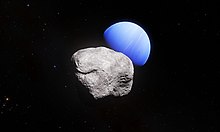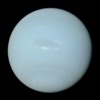希波坎普 (Hippocamp )最初被稱為S/2004 N 1 ,是海王星 的一顆小衛星 ,直徑大約僅有35 km(20 mi),它的軌道週期短於一天 。這顆衛星的發現於2013年7月1日公諸於世,並使海王星的衛星數量增加為14顆[ 7] 航海家2號 在1989年探測海王星時未能發現它。SETI協會 的馬克·肖沃爾特 哈伯太空望遠鏡 在2004年至2009年拍攝的海王星照片找到它[ 8]
2018年9月25日,在小行星通告 111804上正式公告為海衛14,2019年2月命名為希波坎普(Hippocamp)。
馬克·肖華特在2013年7月1日檢視哈伯太空望遠鏡 於2009年拍攝的亞當斯環弧 的影像時發現了希波坎普。他使用一種類似水平搖攝 疊加 [ 7] [ 9] [ 10] [ 11] [ 2] 航海家2號 曾經觀測到海王星所有的內側衛星,但由於它非常昏暗,所以在1989年時沒有觀測到[ 7] [ 2]
希波坎普是自2003年9月發現普薩馬 以後,發現的第一顆海王星的衛星[ 10] [ 12]
海王星最大的衛星崔頓 是一顆軌道逆行 ,且大角度傾斜 的衛星。據推測,崔頓是在原始的海王星系統形成後,才被從古柏帶 捕獲。先前存在的衛星會因為此一事件而改變軌道,導致一些衛星彈射出去或和其它的衛星碰撞而被破壞[ 13] [ 14] 潮汐減速 之後,從碎石的廢墟中吸積 形成的[ 15]
另一個假設認為,希波坎普可能是從最靠近海王星的大衛星,普羅杜斯 (海衛八)受到撞擊產生的碎屑形成的[ 6] [ 4] 法羅斯撞擊坑 噴出的;由這個撞擊坑噴出的物質,體積大約是希波坎普的50倍。希波坎普的軌道相對地靠近普羅杜斯,它們的半長軸 相差約12,000公里。希波坎普可能在距離普羅杜斯只有數千公里之內形成,然後由於它與海王星相互的潮汐作用更為強烈,才與普羅杜斯拉開了距離[ 4]
海王星和它最小的衛星希波坎普(藝術家的概念)[ 16] 一般認為希波坎普的表面類似其它的內側衛星一樣,像"骯髒的瀝青"一樣黑 [ 9] 反照率 範圍在0.07至0.10之間 [ 17] 視星等 估計,它的直徑在16至20公里,使它成為海王星最小的衛星。最近對海王星衛星的觀測顯示,希波坎普的直徑為34.8公里,幾乎是先前估計的兩倍[ 4]
使用哈伯太空望遠鏡的近紅外線照相機和多目標分光儀 (NICMOS)檢查了海王星環和內側衛星的近紅外光譜 [ 18] [ 19] 太陽系小天體 黑暗、紅化物質 的特徵,似乎存在於其所有的表面。資料顯示含有有機化合物碳-氫鍵 (C-H鍵)、和/或碳-氮鍵 (C≡N)的結合[ 19] 天王星 的小衛星)[ 19]
涵蓋到海衛一的衛星軌道圖。特別突出顯示海衛十四希波坎普的軌道。 希波坎普每22小時28.1分鐘(0.9362天)公轉海王星一圈[ 2] 半長軸 ,或軌道距離約為105,283 km(65,420 mi),正好略高於地月距離 的四分之一,或大約是海王星環 平均半徑的兩倍。它的軌道傾角和離心率都接近零[ 2] 拉里薩 和普羅杜斯 之間,成為海王星外層規則衛星 的第二顆。這種衛星的趨勢是直徑隨者與主體行星的距離增加而增加,但它卻反其道而行,是在這個位置上最小的衛星[ 5]
拉里薩和西坡坎普的週期有著3:5的軌道共振 ,差異只有1%左右;而希波坎普和普羅杜斯的週期有差異少於0.1%以內的5:6共振[ Note 1] [ 20] [ 21] [ 20] 同步軌道 之外(海王星的自轉週期為0.6713天[ 22] 潮汐加速 ,而拉里薩在其內,則受到潮汐減速[ 20]
這顆衛星以希臘神話 中的生物,馬頭魚尾怪 (Hippocamp)命名為希波坎普[ 23]
發現小組決定依據古希臘羅馬神話 中與海神波塞冬 或尼普頓 有關的一張圖中,向國際天文學聯合會 提交[ 11] 衛星 一致的名稱[ 24] 波利菲莫斯 (Polyphemus)和托俄薩 (Thoosa)[ 25] 海馬 恰如其分的有著馬頭魚尾[ 3] [ 26]
^ 這三顆衛星的軌道週期各自為0.55465、0.93618和1.12231天,實際的比率值為2.962:5.000:5.994
^ Yeomans, D. K.; Chamberlin, A. B. Planetary Satellite Discovery Circumstances . JPL Solar System Dynamics web site. Jet Propulsion Lab . 2013-07-15 [2013-07-17 ] . (原始内容存档 于2009-08-14). ^ 2.0 2.1 2.2 2.3 2.4 2.5 Kelly Beatty. Neptune's Newest Moon . Sky & Telescope . 15 July 2013 [12 June 2017] . (原始内容存档 于2013-07-16). ^ 3.0 3.1 Ian Sample. ' Breakneck speed' mini moon hurtles around Neptune at 20,000mphThe Guardian . 2019-02-20 [2019-02-20 ] . (原始内容存档 于2021-01-13). ^ 4.0 4.1 4.2 4.3 4.4 4.5 4.6 Showalter, M. R.; de Pater, I.; Lissauer, J. J.; French, R. S. The seventh inner moon of Neptune. Nature. 2019, 566 (7744): 350–353. doi:10.1038/s41586-019-0909-9 ^ 5.0 5.1 Editors of Sky & Telescope . A Guide to Planetary Satellites . Sky & Telescope web site. Sky & Telescope . [2013-07-17 ] . (原始内容 存档于2013-10-16). ^ 6.0 6.1 Karl Hille. Tiny Neptune Moon Spotted by Hubble May Have Broken from Larger Moon . NASA . 2019-02-20 [2019-02-20 ] . (原始内容存档 于2019-02-21). ^ 7.0 7.1 7.2 Hubble Finds New Neptune Moon . Space Telescope Science Institute . 2013-07-15 [2013-07-15 ] . (原始内容存档 于2014-02-21). ^ Nasa's Hubble telescope discovers new Neptune moon . BBC News. 2013-07-15 [2013-07-16 ] . (原始内容存档 于2019-04-04). ^ 9.0 9.1 Showalter, M. R. How to Photograph a Racehorse ...and how this relates to a tiny moon of Neptune . Mark Showalter's blog. 2013-07-15 [2013-07-16 ] . (原始内容 存档于2013-07-18). ^ 10.0 10.1 Grossman, L. Neptune's strange new moon is first found in a decade . New Scientist space web site. New Scientist. 2013-07-15 [2013-07-18 ] . (原始内容存档 于2013-09-02). ^ 11.0 11.1 Klotz, I. Astronomer finds new moon orbiting Neptune . Reuters . 2013-07-15 [2013-07-16 ] . (原始内容 存档于2015-09-24). ^ Marsden, Brian G.; S/2002 N 4 页面存档备份 ,存于互联网档案馆 ), MPEC 2003-S107 (30 September 2003)
^ Goldreich, P.; Murray, N.; Longaretti, P. Y.; Banfield, D. Neptune's story. Science. 1989, 245 (4917): 500–504. Bibcode:1989Sci...245..500G PMID 17750259 doi:10.1126/science.245.4917.500 ^ Agnor, C. B.; Hamilton, D. P. Neptune's capture of its moon Triton in a binary–planet gravitational encounter. Nature. 2006-05-11, 441 (7090): 192–194. Bibcode:2006Natur.441..192A PMID 16688170 doi:10.1038/nature04792 ^ Banfield, Don; Murray, Norm. A dynamical history of the inner Neptunian satellites. Icarus. October 1992, 99 (2): 390–401. Bibcode:1992Icar...99..390B doi:10.1016/0019-1035(92)90155-Z ^ Hubble helps uncover origin of Neptune’s smallest moon Hippocamp . www.spacetelescope.org. [21 February 2019] . (原始内容存档 于2020-11-08) (英语) . ^ Karkoschka, Erich. Sizes, shapes, and albedos of the inner satellites of Neptune. Icarus. 2003, 162 (2): 400–407. Bibcode:2003Icar..162..400K doi:10.1016/S0019-1035(03)00002-2 ^ Dumas, C.; Terrile, R. J.; Smith, B. A.; Schneider, G. Astrometry and Near-Infrared Photometry of Neptune's Inner Satellites and Ring Arcs. The Astronomical Journal. March 2002, 123 (3): 1776–1783. Bibcode:2002AJ....123.1776D ISSN 0004-6256 doi:10.1086/339022 ^ 19.0 19.1 19.2 Dumas, C.; Smith, B. A.; Terrile, R. J. Hubble Space Telescope NICMOS Multiband Photometry of Proteus and Puck . The Astronomical Journal. August 2003, 126 (2): 1080–1085. Bibcode:2003AJ....126.1080D ISSN 0004-6256 doi:10.1086/375909 ^ 20.0 20.1 20.2 Zhang, K.; Hamilton, D. P. Orbital resonances in the inner neptunian system: I. The 2:1 Proteus–Larissa mean-motion resonance. Icarus. June 2007, 188 (2): 386–399. Bibcode:2007Icar..188..386Z ISSN 0019-1035 doi:10.1016/j.icarus.2006.12.002 ^ Zhang, K.; Hamilton, D. P. Orbital resonances in the inner neptunian system: II. Resonant history of Proteus, Larissa, Galatea, and Despina. Icarus. January 2008, 193 (1): 267–282. Bibcode:2008Icar..193..267Z ISSN 0019-1035 doi:10.1016/j.icarus.2007.08.024 ^ Williams, David R. Neptune Fact Sheet . NASA . 1 September 2004 [18 July 2013] . (原始内容存档 于2011-08-17). ^ Timmer, John. Hubble images show a Neptune moon that may have been repeatedly reborn . Ars Technica. 20 February 2019 [21 February 2019] . (原始内容存档 于2020-11-07) (美国英语) . ^ Planet and Satellite Names and Discoverers . Gazetteer of Planetary Nomenclature. USGS Astrogeology. [2013-07-18 ] . (原始内容存档 于2009-10-10). ^ Vincent, James. Astronomers throw open the doors to the public-naming of planets . The Independent . 16 August 2013 [16 August 2013] . (原始内容存档 于2015-09-25). ^ Mortillaro , Nicole. Scientists reveal Neptune's tiny new moon, Hippocamp . CBC News . 20 February 2019 [20 February 2019] . (原始内容存档 于2020-12-13).
维基共享资源 上的相關多媒體資源:海衛十四





